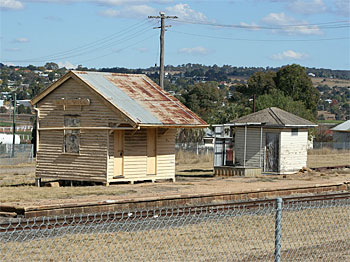(Warwick) Mill Hill Railway Station
Open: 10 January 1871
Renamed: 1888 from Warwick to Mill Hill
Closed: 30 May 1975
Location: Southern Line
Status: Platform & Station building still exist.
Some documentation refer to this location as one word “Millhill”, and some as two-words “Mill Hill”. The station sign that is mounted on the side of the station building is shown as two words.
Rails had reached Warwick by December 1870. On January 10th 1871, Warwick (Mill Hill) Station was officially opened. Within a year two mixed trains were running to Warwick (Mill Hill). It was not due to the business generated at Westbrook, Cambooya, Clifton, or Allora but to the discovery of tin at what became Stanthorpe. Ingot and steam tin consigned from Warwick was such a valuable supplement that the amount was published monthly in the Government Gazette.

What remains of the Mill Hill Station in 2006.
The Warwick (Mill Hill) terminus comprised of a station house, platform, goods shed, engine shed, carriage shed and tank stand, a 25’ turntable and pits. (It is believed that the turntable was transferred to Killarney when a 40 foot turntable was built at East Warwick in 1886-87).
A traffic in ‘stream” (alluvial) tin from Stanthorpe began in 1876 – 16 tons of ingot and 278 tons of stream tin being forwarded. This would lead to the construction of the railway to Stanthorpe.
And on July 6, the running of through trains commenced between Brisbane and Warwick (Mill Hill). Depart Brisbane 6.45 a.m. arrive Warwick 5.37 p.m. Depart Warwick 6.20 a.m. arrive Brisbane 1.15 p.m.
By May 6, 1878 work had started on construction of the line south of Warwick (Mill Hill) to Cherry Gully and Stanthorpe.
In 1881, sheep yards were erected at Warwick (Mill Hill) as well as a new station master’s residence after complaints about the original building. The old station master’s residence became the refreshment rooms in 1883.
Tuesday, January 10, 1888 – (WA) – The new railway yard and buildings at East Warwick, having now been occupied for a week, we are in a position to form some idea as to how they are likely to suit the purpose for which they are being used. As far as the passenger station is concerned, except in one or two details it is all that could be desired. The platform, instead of being cemented or asphalted, as it should have been, is covered with a coarse sandy gravel which will never bind, and must in consequence continue to be (what is has already proved) a source of annoyance and discomfort to the public and to the officers of the department. This matter engaged the attention of the Municipal Council on Wednesday, and it was decided to communicate with the proper authority without delay, with the view to having an alteration effected. The yard is also in a bad state; the filling-up stuff used was soft “muck,” covered with sand and small stones taken from creek beds, into which dray wheels sink six or eight inches. So far nothing has apparently been done to provide the necessary additional buildings. The station master lives nearly two miles from his post of duty, an arrangement which would be a mistake under any circumstances, but which will be something worse than inconvenient when the night train service comes into force next week. There are no facilities for watering the locomotives at East Warwick, and until tanks are provided it will be necessary to stop for water at the old station, which we understand it is proposed to rename Hayesmill. This is a delay which could have been obviated had the various works at East Warwick been pushed on simultaneously. The new goods shed is convenient and roomy, but no doubt if the accommodation will prove sufficient for the inward and outward traffic. At present the Killarney train ha to back in from and out to the Junction, nearly a mile distance from East Warwick.
This arrangement is said to be necessary because the Department cannot afford to spend the small amount (about £1000) which would be required to deviate a few chains of the Killarney line. The bridge over the Condamine, about half a mile in length, intervenes between the Junction and East Warwick, and across this the train is backed. “backing in” trains is a rather dangerous practice, and may prove more costly than an outlay of a few hundred pounds. But the Department seems bent upon economy, and will risk pounds to save pennies. The refreshment room at the passenger station is occupied by the new lessee (Mr. J. Allman, of the Criterion Hotel), who has fitted up the dining room and bar in a manner likely to give every satisfaction to the travelling public. We presume that on the down journey, Brisbane to Sydney, the stoppage for dinner will be made at Warwick. It is a pity that a cellar was not provided for in the original plan, for it is almost impossible to keep liquor cool in such a climate as ours without a convenience of this kind. However, a cellar has been promised, and we presume it will be provided in due course. As is the custom with our much-manned Railway Department, the Assistant Engineer will doubtless be instructed to “furnish a report upon the subject;” this will be submitted to the Principal Assistant Engineer for advice, and passed on to the Chief Engineer and Engineer for Existing Lines for approval; then the Traffic Manager will be asked to concur, and having done so he will advise the Commissioner accordingly; Mr. Curnow will due course consult with the Minister, and it is quite within the bounds of possibility that the latter will decide that the proposed improvement is not required. Our Railway Department is a complex piece of machinery, which “moves in a mysterious way its wonders to perform.” It has been tinkering at east Warwick for more than two years, but the establishment is still in a very unsatisfactory condition of incompleteness.
Upon the opening of Warwick East Railway Station, many changes quickly took place at Warwick (Mill Hill) Station. The Commissioner for Railways opened the new sandstone station and goods shed at East Warwick on 3rd January 1888.
January 3, 1888 – (WA) – RAILWAY TRAFFIC – The new passenger station and goods shed at East Warwick were occupied by the officers of the Railway Department for the first time yesterday. Hence forth traffic arrangements will be conducted from this point; the old station at North Warwick (which is to be renamed) will, however, be used for passenger traffic, and also for goods by those who desire to have their freight delivered there.
It wasn’t long before East Warwick became the new Warwick Terminus and the original ‘Warwick’ station was renamed ‘Mill Hill’.
Most of Mill Hill’s infrastructure was moved to other stations. Passenger traffic and freight traffic continued for many years, and Mill Hill is an important chapter in Warwick’s History
Mill Hill was closed as an official station on Friday, 30th May, 1975.
